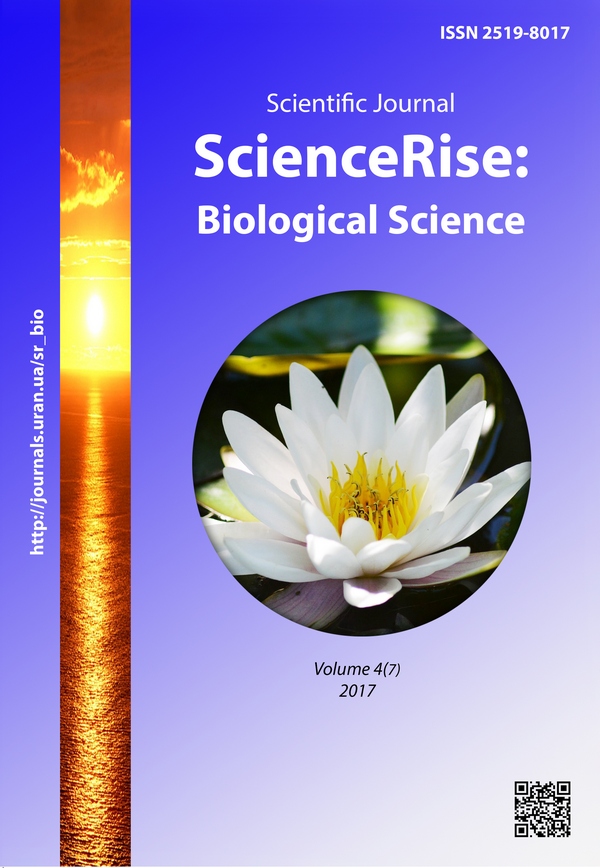Оцінка загального функціонального стану центральної нервової системи студентів молодших курсів факультету фізичного виховання
DOI:
https://doi.org/10.15587/2519-8025.2017.109302Ключові слова:
зорово-рухова реакція, функціональний рівень системи, стійкість реакції, рівень функціональних можливостейАнотація
Проведено дослідження динаміки функціонального стану центральної нервової системи студентів молодших курсів факультету фізичного виховання за результатами простої зорово-рухової реакції під впливом дозованого фізичного велоергометричного навантаження за замкнутим циклом (з реверсом). Встановлено два основні типи реакцій загального функціонального стану мозку юнаків, які характеризуються різними спрямованістю, глибиною зрушень та кількісним їх співвідношенням
Посилання
- Agadzhanyan, N. A., Radysh, I. V. (2009). Kachestvo i obraz zhizni studencheskoy molodezhi [Quality and lifestyle of students]. Ekologiya cheloveka [Human Ecology], 5, 3–8.
- Kaznacheev, V. P. (1980). Sovremennye aspekty adaptatsii [Modern aspects of adaptation]. Novosibirsk: Science, 192.
- Makarenko, M. V., Lyzohub, V. S., Petrenko, Yu. O., Bibik, T. A., Yavnyk, O. E., Yukhymenko, L. I. (2002). Funktsionalnyi stan tsentralnoi nervovoi systemy za umov pererobky informatsii riznoho stupenia skladnosti u osib z riznym rivnem rukhlyvosti nervovykh protsesiv [The functional state of central nervous system conditions for processing the information of varying difficulty in individuals with different levels of mobility of nervous processes]. Fiziolohichnyi zhurnal [Physiological Journal], 48 (1), 9–14.
- Shcherbatyh, Yu. V. (2000). Samoregulyatsiya vegetativnogo gomeostaza pri emotsional'nom stresse [Self-regulation of vegetative homeostasis under emotional stress]. Fiziologiya cheloveka [Human physiology], 26 (5), 151–152.
- Meerson, F. Z., Pshennikova, M. G. (1988). Adaptatsiya k stressornym situatsiyam i fizicheskim nagruzkam [Adaptation to the stress situations and physical loads]. Moscow: Medicine, 256.
- Anokhin, P. K. (1975). Ocherki po fiziologii funktsional'nyh sistem [Essays on the Physiology of Functional Systems]. Moscow: Medicine, 448.
- Bayguzhin, A. P. (2011). Faktory rezul'tativnosti psihofiziologicheskogo issledovaniya funktsional'nogo sostoyaniya tsentral'noy nervnoy sistemy u studentov [Factors of effectiveness of psychophysiological study of the functional state of the central nervous system in students]. Vestnik YUUrGU. Seriya «Obrazovanie, zdravoohranenie, fizicheskaya kul'tura» [Bulletin of South Ural State University. Series «Education, Health Care, Physical Culture»], 26, 131–135.
- Belenko, I. S. (2009). Psihofiziologicheskie osobennosti u yunyh sportsmenov igrovyh vidov sporta raznogo vozrastnogo perioda razvitiya i trenirovannosti [Psychophysiological features of young sportsmen of game kinds of sports of different age period of development and training]. Vestnik TGPU [Bulletin of TSPU], 3 (81), 54–58.
- Dobrostan, O. V., Pliska, O. І. (2014). Psykhofiziolohichni osoblyvosti adaptatsii pershokursnyts z riznym indeksom masy tila [Freshman adaptation physiological characteristics with different body mass index]. Indyvidualni psykhofiziolohichni osoblyvosti liudyny ta profesiina diialnist. Cherkasy, 32.
- Loskutova, T. D. (1977). Funktsional'noe sostoyanie tsentral'noy nervnoy sistemy i ego otsenka po parametram prostoy dvigatel'noy reaktsii [The functional state of the central nervous system and its evaluation of the parameters of a simple motor reaction]. Leningrad, 24.
- Bosenko, A. I., Shumeiko, K. P. (2007). Pat. No. 20869 UA. Prystrii dlia diahnostyky funktsionalnoho stanu mozku liudyny «Molnyia» [The device for the diagnosis of the functional state of the human brain]. MPK: A61B 5/103, A61B 5/16. No. u2006093326; declareted: 28.06.2006; published: 15.02.2007; Bul. No. 2, 6.
- Davidenko, D. N. (2011). Metodika otsenki mobilizatsii funktsional'nyh rezervov organizma po ego reaktsii na dozirovannuyu nagruzku [Method of assessing body’s functional reserve mobilization in case of its response to controlled activity]. Nauchno-teoreticheskiy zhurnal «Uchenye zapiski universiteta imeni P. F. Lesgafta» [Scientific and theoretical journal “Schoolarly notes of Lesgaft University”], 12 (70), 52–57.
- Bosenko, A. I. (1986). Vyyavlenie funktsional'nyh vozmozhnostey serdechno-sosudistoy i tsentral'noy nervnoy sistem u podrostkov pri napryazhennoy myshechnoy deyatel'nosti [Discovering functional capacity of cardiovascular and central nervous system in adolescents in case of intensive muscular work]. Tartu, 25.
- Baevskiy, R. M., Berseneva, A. P. (1997). Otsenka adaptativnyh vozmozhnostey organizma i risk razvitiya zabolevaniy [Assessment of adaptive capabilities of the body and the risk of developing diseases]. Moscow: Medicine, 236.
- Zimkina, A. M., Klimova-Cherkasova, V. I., Povorinskiy, A. G.; Zimkina, A. M., Klimova-CHerkasova, V. I. (Eds.) (1978). Neyrofiziologicheskie issledovaniya v ekspertize trudosposobnosti [Neurophysiological research in work capacity examination]. Leningrad: Medicina, 280.
##submission.downloads##
Опубліковано
Як цитувати
Номер
Розділ
Ліцензія
Авторське право (c) 2017 Anatolii Bosenco, Maria Topchii

Ця робота ліцензується відповідно до Creative Commons Attribution 4.0 International License.
Наше видання використовує положення про авторські права Creative Commons CC BY для журналів відкритого доступу.
Автори, які публікуються у цьому журналі, погоджуються з наступними умовами:
1. Автори залишають за собою право на авторство своєї роботи та передають журналу право першої публікації цієї роботи на умовах ліцензії Creative Commons CC BY, котра дозволяє іншим особам вільно розповсюджувати опубліковану роботу з обов'язковим посиланням на авторів оригінальної роботи та першу публікацію роботи у цьому журналі.
2. Автори мають право укладати самостійні додаткові угоди щодо неексклюзивного розповсюдження роботи у тому вигляді, в якому вона була опублікована цим журналом (наприклад, розміщувати роботу в електронному сховищі установи або публікувати у складі монографії), за умови збереження посилання на першу публікацію роботи у цьому журналі.










